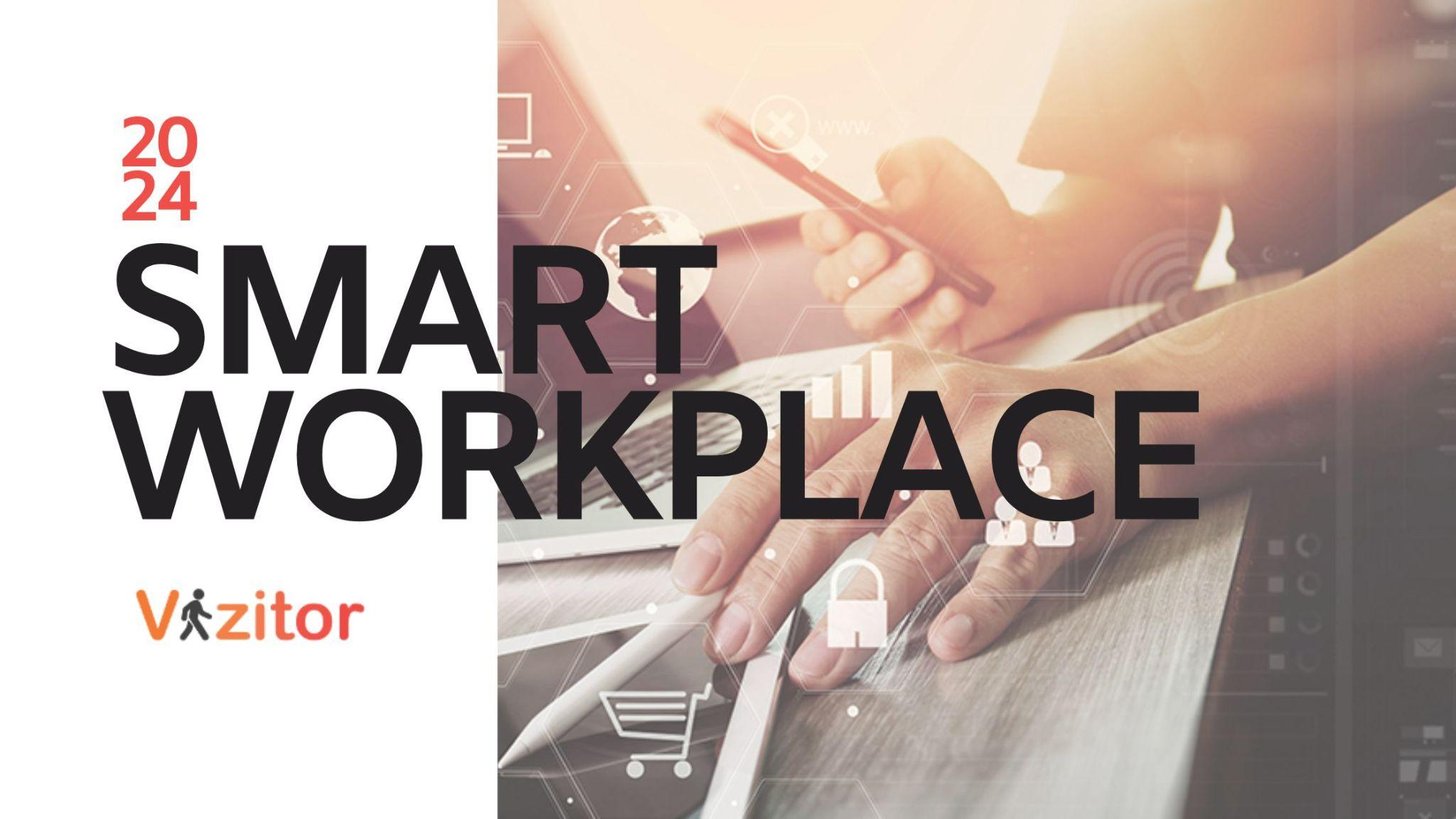Table of Content
Try Vizitor for Free!

Tue, May 21, 2024
Read in 8 minutes
Welcome to the era of Smart Workplaces, where technology is revolutionizing how we work. Did you know that by 2025, 75% of the global workforce will be millennials—a generation known for embracing digital innovations?
A smart workplace refers to a technology-enabled environment that enhances productivity, efficiency, and employee collaboration. It leverages cutting-edge technologies like IoT, AI, and data analytics to automate tasks, streamline processes, and create a connected workspace.
Key Statistics:
- Smart workplaces can improve productivity by up to 25%.
- Around 70% of organizations are expected to adopt at least one type of smart office technology by 2025.
- The global smart workplace market is projected to exceed $50 billion by 2026, growing at a CAGR of 14%.
What Is a Smart Workplace?
A smart workplace refers to a modern, technology-enabled environment designed to enhance productivity, efficiency, and employee collaboration. It leverages various technologies like IoT (Internet of Things), AI (Artificial Intelligence), and data analytics to automate tasks, streamline processes, and create a more connected and interactive workspace.
• Did you know? One study found that smart workplaces can improve employee productivity by up to 25%.
• By 2025, it’s estimated that around 70% of organizations will have adopted at least one type of smart office technology.
• The global smart workplace market size is expected to reach over $50 billion by 2026, growing at a CAGR of around 14%.
Examples of Smart Workplace Technologies:
• IoT Sensors: These can monitor occupancy levels in meeting rooms, adjust lighting and temperature based on employee presence, and manage energy usage efficiently.
• Collaboration Tools: Platforms like Microsoft Teams or Slack facilitate seamless communication, file sharing, and project collaboration, reducing email clutter and improving team efficiency.
• AI-powered Analytics: Software applications that analyze employee behavior and workspace utilization data can provide insights to optimize office layouts, improve resource allocation, and enhance employee well-being.
• Smart Access Control: Systems using biometric authentication or RFID cards provide secure and convenient access to buildings and restricted areas, ensuring workplace safety.
Live Examples From The Best
• Amazon Go Stores: These cashier-less retail stores use AI and sensor technology to track purchases, offering a seamless and efficient shopping experience.
• Google Workspace: Formerly known as G Suite, Google Workspace integrates email, document editing, video conferencing, and collaboration tools into a unified platform for improved productivity and communication.
• Smart Building Management: Companies like Siemens offer solutions for smart building management, including HVAC control, lighting optimization, and space utilization tracking, leading to energy savings and a more comfortable work environment.
Why Are Workplaces Becoming Smarter?
The shift towards smarter workplaces is driven by the desire to create more agile, efficient, and employee-friendly environments that can adapt to the rapidly evolving business landscape. Workplaces are becoming smarter due to several key reasons:
1. Enhanced Efficiency:
Smart technologies automate repetitive tasks, streamline processes, and optimize resource utilization, leading to increased efficiency and productivity. For example, AI-powered software can handle routine customer inquiries, freeing up human employees to focus on more complex tasks.
2. Improved Collaboration:
Smart workplace tools like video conferencing platforms and cloud-based collaboration software enable teams to work together seamlessly regardless of their physical location. This fosters better communication, faster decision-making, and enhanced teamwork.
3. Cost Savings:
Smart technologies can help reduce operational costs through energy-efficient systems, optimized space utilization, and remote work capabilities. For instance, IoT sensors can monitor energy usage in buildings and automatically adjust lighting and HVAC systems to conserve energy.
4. Employee Satisfaction:
Smart workplaces often provide a more flexible and engaging environment for employees. Features like flexible working hours, remote work options, and personalized workspace settings contribute to higher job satisfaction and employee retention.
5. Competitive Advantage:
Companies that embrace smart technologies gain a competitive edge by staying ahead of market trends, adapting quickly to changes, and delivering better products or services to customers. This can lead to increased market share and business growth.
6. Data-Driven Decision Making:
Smart workplace technologies collect and analyze vast amounts of data, providing valuable insights into employee behavior, customer preferences, and operational performance. This data-driven approach helps organizations make informed decisions and optimize their strategies for success.
What Are Some of the Benefits of a Smart Workplace?
A smart workplace leverages advanced technologies to create an efficient, connected, and productive environment for employees. These technologies, including IoT devices, AI-powered systems, and data analytics tools, are transforming traditional workspaces into dynamic hubs of innovation.
The International Data Corporation (IDC) predicts that investments in smart office technologies will reach $47.7 billion by 2023, indicating a growing trend towards intelligent work environments.
• Enhanced Productivity: Smart technologies automate tasks, streamline workflows, and provide real-time insights, allowing employees to focus on high-value work and achieve more in less time.
• Improved Collaboration: Collaboration tools and platforms facilitate seamless communication, file sharing, and project coordination among teams, regardless of their physical locations.
• Cost Savings: Smart office solutions optimize energy usage, space utilization, and resource allocation, leading to reduced operational costs and improved sustainability.
• Employee Satisfaction: Features like flexible working arrangements, personalized workspaces, and wellness initiatives contribute to higher job satisfaction, better work-life balance, and increased employee retention.
• Data-Driven Decisions: Data analytics and AI-driven insights enable organizations to make informed decisions, identify trends, and adapt strategies to meet business objectives more effectively.
• Competitive Advantage: Adopting smart workplace technologies gives companies a competitive edge by fostering innovation, agility, and responsiveness to market demands.
Types of Technology That Have Changed the Workplace
1. Desk booking software
Desk booking software allows employees to reserve desks or workstations based on their needs and schedules. This technology is particularly useful in flexible work environments where employees may not have assigned desks. Companies like WeWork and Condeco offer desk booking solutions that enable organizations to optimize office space usage and accommodate varying work patterns.
2. Room Booking Software
It streamlines the process of scheduling and managing meeting rooms, conference halls, and other shared spaces within the workplace. Examples include Microsoft Outlook’s room booking feature and software from Robin, which allows employees to book meeting rooms conveniently and avoid scheduling conflicts.
3. IoT Sensors
IoT sensors are used to gather data and monitor various aspects of the workplace environment, such as occupancy levels, temperature, lighting, and air quality. Companies like Philips Hue provide IoT lighting solutions that adjust lighting based on occupancy, enhancing energy efficiency and employee comfort.
4. Employee Badge Data
This software is often collected through access control systems, provides insights into employee movements within the workplace. This data can be used for security purposes, attendance tracking, and optimizing space utilization. Companies like HID Global offer access control solutions that integrate badge data with other workplace management systems.
5. Digital Wayfinding
The software’s solutions use interactive maps and signage to help employees navigate large office buildings or campuses efficiently. For example, Aruba Networks provides digital wayfinding solutions that use Wi-Fi and Bluetooth technology to guide employees to their desired locations within the workplace.
6. Stack and Scenario Planning Tools
It helps organizations visualize and plan office layouts, seating arrangements, and workspace designs. These tools, such as Archibus and SpaceIQ, allow companies to experiment with different scenarios and optimize space usage based on employee needs and preferences.
7. Facility Management Software
Facility management software centralizes the management of building facilities, maintenance tasks, equipment, and services. Companies like IBM (with its TRIRIGA software) and ServiceNow offer facility management solutions that automate workflows, track maintenance requests, and ensure optimal functioning of workplace assets.
Who Can Create A Smart Workplace For You?
Vizitor stands out as an excellent workplace management solution capable of transforming traditional offices into smart, efficient environments. Its sophisticated visitor management capabilities simplify the check-in procedure for guests, contractors, and suppliers, boosting security through careful tracking and compliance enforcement.
Digital check-in options offered by Vizitor—such as self-service kiosks and smartphone apps—ensure a smooth, frictionless experience. These features reduce wait times, alleviate receptionist workloads, and enhance the overall visitor experience. By eliminating manual processes, Vizitor enables a more streamlined and professional workplace environment.
Emphasizing data privacy and compliance, Vizitor securely stores visitor information and offers options for data retention and deletion, adhering to regulations like GDPR. This ensures businesses can operate securely while meeting global data protection standards.
Additional Features of Vizitor Include:
- Smart Access Control: Easily monitor and restrict access to sensitive areas with digital badges and biometric solutions.
- Customizable Workflows: Tailor visitor processes to suit your business needs, enhancing operational efficiency.
- Real-Time Insights and Analytics: Gain valuable data on visitor flow, office usage, and peak hours, helping businesses make data-driven decisions.
- Seamless Integration: Vizitor integrates with existing office systems, creating a unified workplace ecosystem.
Vizitor: Redefining Smart Workplaces, One Check-In at a Time!
Conclusion
Creating a smart workplace involves more than just integrating advanced technologies—it’s about fostering a connected, productive, and secure environment that empowers employees and enhances operational efficiency. Solutions like Vizitor are paving the way for businesses to embrace the future of work by streamlining visitor management, enhancing security, and ensuring data privacy compliance.
By leveraging tools like IoT sensors, collaboration platforms, and AI-powered analytics, organizations can revolutionize their workspaces to meet the evolving demands of a hybrid workforce. From seamless check-ins to personalized employee experiences, smart workplace technologies unlock new levels of productivity and employee satisfaction.
With global trends pointing toward a digitally native workforce, investing in tools like Vizitor positions your company at the forefront of workplace innovation. Whether you’re looking to improve collaboration, enhance security, or optimize resource utilization, adopting smart workplace solutions is no longer an option—it’s a necessity for businesses that want to thrive in the future.
Start your transformation today. Let Vizitor help you redefine what it means to work smart!










